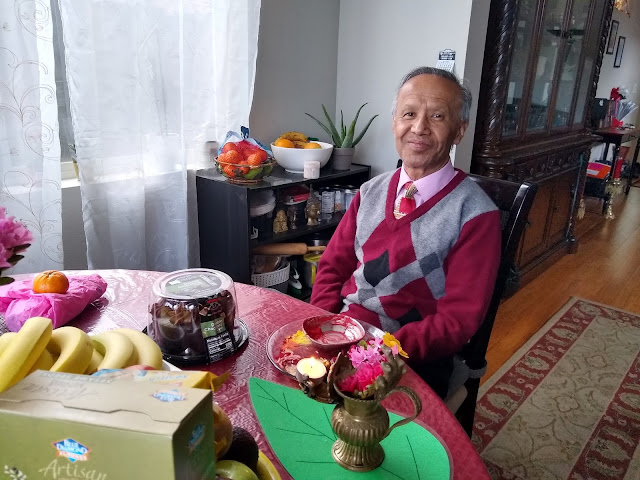Dr Rabin Man Shakya
Portland, Nov 11 (Nepal Oregon News): Nritya Mandala Mahavihara (NMM), which is the only Nepalese Buddhist temple in the West celebrated its eleventh anniversary in Portland, Oregon on Tuesday, Nov. 10, 2020 amid the ongoing coronavirus pandemic.
The eleventh anniversary of the Mahavihara started with the Kush Puja in the morning at the Mahavihara. The rituals of Kush Puja was performed by Mahavihara's co-founder and priest Prajwal Ratna Vajracharya.

Kush Puja is a Newah Buddhist Tantric ritual. The Puja is an esoteric one which usually is confined to the Newah Buddhist devotees who have been ordained with Nhikan Yayegu rituals at the shrines of the houses of the Shakyas and Bajracharyas.

Prajwal says,"Because of the pandemic, we are celebrating the temple's anniversary with social distancing and pandemic guidelines."
Kush Puja consists of different rituals with traditional and religious components. Among others, five grounding nectars in the form of five different kinds of alcohol and five different kinds of meat are used in the Puja.
In this Puja, emphasis is laid on Go Ku Da Ha Na, in which a cow is considered as a harmless creature, a dog is regarded as a sensitive animal, a horse gives continuity, an elephant is treated as a fearless creature, whereas Nara (or man) is known for his knowledge. The purpose of the Puja is to raise the consciousness of our own body and mind, Vajracharya, the senior pujari at the Mahavihara told a journalist from Nepal Oregon News, USA.
On the occasion, 108 butter fed lamps were also lit. Similarly, refugee dance was performed by Prajwal Vajracharya and other Sangha members.
At the end of the Puja, Prajwal Guruju handed over small pieces of sacred flowers and sacred Kokha to the Sangha members and dabbed Hyaungu Sinha and Haku Sinha on their foreheads.
Kaula (Prasad) and Samaya Baji was served to the participants of the Kush Puja on the occasion. Bulla (a Newah style soup made of fermented rice) was the center of attraction of the Samaya Baji.
The other important part of the eleventh anniversary was the performance of Charya dances.
Charya dance program was launched on Zoom because of the pandemic. Charya dancers from different parts of the USA, Nepal, Hong Kong, Brazil and Germany demonstrated their wonderful and amazing talent.
Because of the time zone difference, dancing through Zoom was arranged in the morning and in the evening. Both morning and evening sessions of international Charya dancing were moderated by Kuon Hunt, a member of the Sangha.
In the morning session of the dance program, Yamuna Baker from Germany performed Vajrayogini, Saldon Wu from Hong Kong presented Kurukulla dance, Vesta Corradini from Brazil showed Arya Tara dance whereas Anupama Dahal's students from Nepal demonstrated a Pancha Tara dance. Similarly, Bunu Shrestha (Bajracharya) from Germany performed White Tara while Prajwal Vajracharya presented a dance 'Maya Jaal.'
In the evening session of the dance program, a dance called 'Nairatma' was performed by Bunu Shrestha while Yogini Mandala was presented by Corinne Nakamura. A team of Charya dancers from Hong Kong including Tina Ho, Eliza La, Kerry Ho, Eliza Lau LY, Chin Chin Chang performed a dance 'Vajrasattva.'
 |
Charya nritya dance 'Vajrasattva'
|
A dance 'Arya Tara' was presented by Shahrazad Huisman from Germany, while Kumari dance was performed by Kalpana Bajracharya from Nepal. Likewise, Annapurna dance was carried out by Uppa Shakya, USA and Sky Dakini dance was performed by Anna Shrustova, also USA. And finally, a Mahankaal dance was presented by Prajwal Vajracharya.
 |
| Sixteen offering goddess charya dance. |
The vocal rendition for most of the Charya dances was provided by Joshua Proto, a Sangha member.
About 65 people had participated in the Zoom dance program in the evening and about 50 people in the morning. Among them, notable were Prof Dr Linda Iltis from Washington, Prof Dr Myrinda Shaw from California, Helen Appell, co-founder of the Mahavihara, Dr Shubhash Ram Prajapati from Washington, Dr Mahendra Man Shakya (Physics) from California, Home Shrestha a Ph D researcher from Canada, Daya Shakya, vice president of World Newah Organization and so on.
 |
| Participants on Zoom during the event |
In the last 11 years, Nritya Mandala Mahavihara has continuously served the sangha or community in many ways, and credit for this goes to co-founders duo Prajwal and Helen Appell.
In fact, many of Portland's Nepalese community activists coming from different spectrums have mentioned it as one of the quintessential aspects of Prajwal's unrelenting campaign to promote, preserve and protect the Buddhist traditions of Nepal.
The Mahavihara has provided a wide range of cultural, life cycle and calendrical rituals based on Newar Vajrayana Buddhism and Newah and Nepali traditions.
NMM has offered teachings and presentations, including by recognized scholars from around the world.
It has offered instruction and organized performances of Charya dances, as well.
While the temple itself has been closed during the pandemic, NMM has continued in the same spirit with zoom classes on Dharma, Dharani, Sadhana, Sanskrit, Charya Giti singing, Charya dance and scholarly lectures.
(Rabin Man Shakya is a Nepali journalist in USA)

































